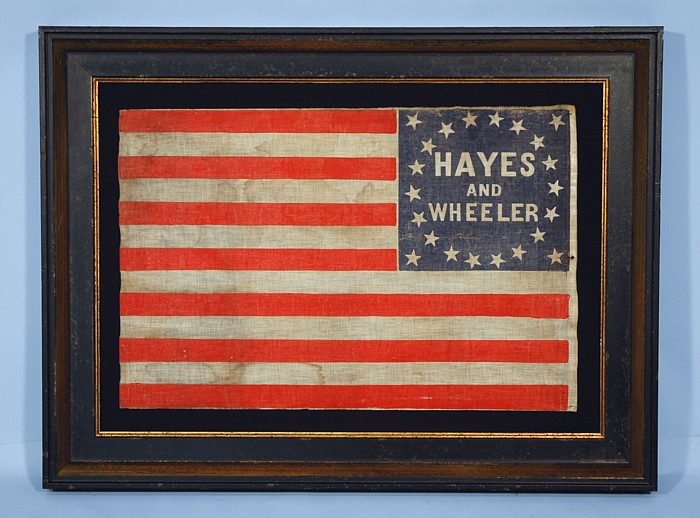
| |
22 STARS , HAYES & WHEELER CAMPAIGN, 1876 ELECTION, THE ONLY KNOWN EXAMPLE |
|
| Available: |
Sold |
| Frame Size (H x L): |
27.25" x 36" |
| Flag Size (H x L): |
18" x 27.25" |
|
| Description....: |
|
| 22 STARS , HAYES & WHEELER CAMPAIGN, 1876 ELECTION,
THE ONLY KNOWN EXAMPLE, MEDALLION CONFIGURATION WITH CENTER TEXT:
22 star American national parade flag, made for one of the most peculiar presidential campaigns in American history, the 1876 contest between Rutherford B. Hayes and Samuel L. Tilden. Printed on coarse, glazed cotton, the flag has a beautiful medallion configuration, inside which the names of the candidates appear.
This beautiful example is arguably the best of all known Stars & Stripes parade flags made for the Hayes & Wheeler Campaign. It is the only one of its kind and, hands down, is my personal favorite among all such flags that have thus far surfaced. Hayes and Wheeler flags with text or portraits are exceptionally rare to begin with and it seems evident that very few were made. Only two styles are pictured in the 1979 Smithsonian Press text, Threads of History [p. 215], by Herbert Ridgeway Collins, the Smithsonian's curator of political history. One of these is in the Smithsonian's own collection [plate 461]. It shows two large portraits of the candidates in the stripes with their desired offices above and corresponding names underneath. At least two more examples of this same flag have surfaced in private hands, and this has proved to be one of the most sought after designs in all of political flag collecting. Thought both candidates are shown and the portraits are of exaggerated size when compared to other political parade flags, the overall presentation has never been one that held my interest aesthetically. Though highly detailed, the portraits are homely. The star configuration is hopelessly benign and the overall layout is simply unbalanced. The other style [plate 461], is less unusual but is actually more pleasing visually. The star design is 6 justified rows of 6 stars, however, and although it bears some folk qualities, it isn't in the same league as a wreath pattern. Further, text in the stripes is more common than text in the canton.
The 22 star count and even the placement of the stars probably has a hidden meaning. At the end of the Civil War there were 36 states, 22 of which supported the Union. 36 less 22 equals 14, the number of states that officially seceded to the Confederacy, plus the two bordering states that sent troops and were largely in support of the Confederate cause (Missouri and Kentucky). The 4 flanking stars outside the could also be construed as the 4 states that joined the Union after 1861, the war's opening year, which were all Free States. Because medallion configurations often had a star in each corner, this is probably coincidental, but the total count of 22 stars is probably a Civil War reference. Like most presidential candidates in the post-Civil War 19th century, Hayes was a Union Army officer, attaining the rank of brigadier general. Using 22 stars would be a subtle means by which Hayes could display his allegiance to his fellow veterans, or if the flag was designed his supporters, they could have used the count of 22 to prove a point. Members of the Republican Party were known to chant "Not every Democrat was a Rebel, but every Rebel was a Democrat", so the Civil War issue obviously remained critical in 1876.
[Inquire for a full description] |
|
|
|
| Collector Level: |
Flags for the truest Patriots. My best offerings |
|
| Flag Type: |
Parade flag |
|
| Star Count: |
22 |
|
| Earliest Date of Origin: |
1876 |
|
| Latest Date of Origin: |
1876 |
|
| State/Affiliation: |
Colorado |
|
| War Association: |
1866-1889 Indian Wars |
|
| Price: |
No |
|
| |
Views: 3348 |
|
|
|

